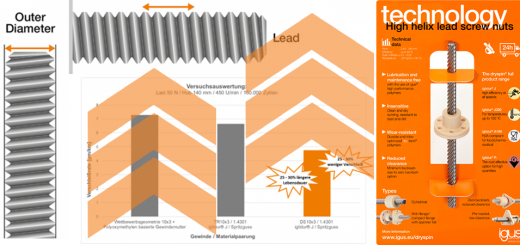What are the advantages of optimizing a moving application?
Original article appeared on https://blog.igus.eu/optimisation-of-a-moving-application/
By Beke Nieszytka
Due to installation space, encoder and motor cables are usually laid parallel to each other. They are from the same control cabinet, go through the same cable conduit, move together through the same energy chain and are finally fastened to the connections of the motor that lie side by side. The mutual influence on signals when network, encoder or servo signals run side by side is often not easy to estimate.
The initial impulse of the motor (starting current) as well as the length of the connecting cables or possible surrounding conditions (e.g. a shaft furnace in close proximity, a welding cell, a frequency converter or other sources of disturbance) have a significant influence.

Furthermore, every interface increases the risk of the plant being affected by external sources of disturbance. Often, intermediate connections that are screwed onto sheet metal via connector housing and sleeve housing cannot be avoided. Especially when a machine is converted or modifications come up in the construction process and the cable has to be lengthened, many operators use an entirely new cable that fits lengthwise instead of an extension cable with male and female contacts.
The intermediate connectors have an advantage for handling individual assemblies, but they can also – particularly if they have been badly processed – have negative effects on the machine. By means of connector plates that have been included well in the plant, the entire machine can be split into assemblies that are easy to handle. These assemblies make your system modular, allowing components to be exchanged in only a few steps.
Advantages of optimizing a moving application
Do the advantages of the modularity in assemblies outweigh the risks of electronic magnetic interferences?
In the meantime, there are different solutions for making sure an assembly can be handled in a modular way or is reliable in use. In this article, we would like to present a solution that in addition to the advantages mentioned above allows for a clear coding of the elements to ensure connection security e.g. for untrained staff, small installation spaces or adverse lighting conditions.
Reduce standstill times, simplify handling, optimize process
All connecting cables and further movable parts, such as the energy chain, can be optimized with modular plug-in connectors that are individually adjusted to the application. This enables a defined and easy-to-handle interface that ensures the exchange of an assembly.

Reduce overtime
Normally, the control cabinet is placed at a certain distance from the field in which the motors, encoders, sensors, light barriers, safety contacts and emergency off-switches are kept.
Before commissioning (IBN) at the end customer’s site, every plant is set up, parameterized and tested at the manufacturer. That means that all components are connected according to the specification. After the successful final control, the plant is disassembled into a few basic modules and packed up for transport. As the transport route or the packaging options are crucial here, the finally tested plant is disassembled correspondingly. At the production site of the end customer, the individual parts are delivered to their destination and connected again. The IBN technicians often spend several days setting up and connecting the plant again according to the documentation. Here, errors can occur which have to be laboriously found and fixed.

Simple maintenance, safe operation
Highly cyclical and fast applications as they are typically required in a machine tool, can also benefit from a modular assembly. Electric cables and hydraulic hoses are used in a multi-axis system, which is then installed in the corresponding machine as an assembly. Here, materials and components have to be matched to each other to ensure a smooth production and long service life.

The examples mentioned above show you possibilities for optimizing your processes. In case you are interested and would like a personal consultation, the igus® project managers are happy to help you. We will advise you individually concerning modular plug-in connectors (Module Connect) or interface-optimized energy supply systems (readychain® Standard or Standard +).
We are happy to inform you of our ready-to-install energy chains on transport racks (readychain® Premium on readychain® rack), which can be installed directly at defined mounting points in your machine.
To learn more about Module Connect, visit our webpage. If you have questions about a specific application or part, contact an expert.



